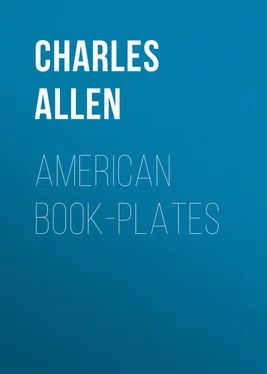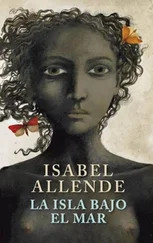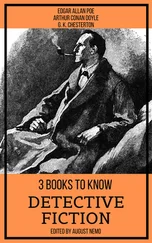Charles Allen - American Book-Plates
Здесь есть возможность читать онлайн «Charles Allen - American Book-Plates» — ознакомительный отрывок электронной книги совершенно бесплатно, а после прочтения отрывка купить полную версию. В некоторых случаях можно слушать аудио, скачать через торрент в формате fb2 и присутствует краткое содержание. ISBN: , Жанр: foreign_antique, foreign_prose, на английском языке. Описание произведения, (предисловие) а так же отзывы посетителей доступны на портале библиотеки ЛибКат.
- Название:American Book-Plates
- Автор:
- Жанр:
- Год:неизвестен
- ISBN:http://www.gutenberg.org/ebooks/47682
- Рейтинг книги:5 / 5. Голосов: 1
-
Избранное:Добавить в избранное
- Отзывы:
-
Ваша оценка:
- 100
- 1
- 2
- 3
- 4
- 5
American Book-Plates: краткое содержание, описание и аннотация
Предлагаем к чтению аннотацию, описание, краткое содержание или предисловие (зависит от того, что написал сам автор книги «American Book-Plates»). Если вы не нашли необходимую информацию о книге — напишите в комментариях, мы постараемся отыскать её.
American Book-Plates — читать онлайн ознакомительный отрывок
Ниже представлен текст книги, разбитый по страницам. Система сохранения места последней прочитанной страницы, позволяет с удобством читать онлайн бесплатно книгу «American Book-Plates», без необходимости каждый раз заново искать на чём Вы остановились. Поставьте закладку, и сможете в любой момент перейти на страницу, на которой закончили чтение.
Интервал:
Закладка:
Dated plates also rank among the more valuable examples. A glance at the chronological list will show how small a number of these we can boast: many of those appearing in the list, too, are simply printed name-labels, which do not rank as high as the more pretentious specimens. Our very earliest dated example is the label of the Rev. John Williams , 1679, the first minister in Deerfield, Mass., and who with his wife and children was carried into captivity by the Indians in 1704. Coming next are the plates of Francis Page , 1703, and William Penn , 1703, but they are both of English make. The plate of Thomas
Prince , who was for forty years the pastor of the Old South Society in Boston, is a simple label dated 1704. The plate of Thomas Dering , signed by Hurd, and dated 1749, is the first American plate by an American engraver that is both signed and dated. The John Burnet , by Dawkins, dated 1754, is next in order; then comes the Greene plate, by Hurd, 1757, the Albany Society Library , 1759, concerning which very little is known, and every few years an example until we come to the opening of the century.
Naturally the artistic quality of a book-plate influences its value; the more elaborate designs are preferred to the plain armorials or the printed labels. Pictorial plates, introducing bits of landscape, interiors of libraries, or allegorical subjects, are sought for, as are plates which are accepted as particularly good types of the different styles. In addition to these technical reasons for valuing one plate more highly than another may be given others which will appear more reasonable perhaps to the general reader. All articles belonging to the noted men of the past have a certain antiquarian value greater than attaches to the kindred belongings of their contemporaries of lesser or no fame. So with book-plates.
A glance at the list will show a goodly number of names which we remember with pride and interest; the names of patriots, orators, lawyers, statesmen, officers of the army, officers of the state and nation, members of Congress, signers of the Declaration, governors, old-time merchants, authors, divines, physicians, and not a few of that plucky number who stood by the King in trying times – the American Loyalists. Quakers, too, as well as royal office-holders, and titled Americans are among those whose book-plates have come down to us.
Of our early Presidents, the plates of George Washington, John Adams, John Quincy Adams, and John Tyler are known to us. All of these except the last, which is a plain printed label, are armorial.
Members of the Boston Tea Party, of the Constitutional Convention, and of the early Assemblies are among those whose plates we know.
Of royal officers we have: Craven, one of the Lords Proprietors of South Carolina; Elliston, Collector of His Majesty’s Customs at New York; Sir William Keith, Governor of Pennsylvania; John Tabor Kempe, Attorney-General under the Crown at New York; and William Penn, Proprietor and Governor of the colony which bore his name.
Owners of large estates, employers of numbers of slaves, merchants whose vessels carried on a trade with remote and prosperous shores, and who established names that have endured, used book-plates which are still known to us. Among these are the plates from the following families, well-known in New England: Ames, Bowdoin, Cabot, Chandler, Chauncey, Coffin, Lodge, Lowell, Minot, Quincy, Sears, Winthrop, Barrell, Greene, Perkins, Swan, Vassall, and Vaughan.
Of those well-known in and about New York may be mentioned, Clinton, Colden, Constable, Cutting, De Peyster, Duer, Ellery, Goelet, Hoffman, Ogden, Paulding, Phillipse, Pintard, Van Cortlandt, and Van Rensselaer. To these should be added the Livingstons, which family had the largest number of book-plates of any we know.
In Philadelphia were the Logans, Morgans, Powels, Banckers, and Hamiltons; while further South, the Lees, Lightfoots, Tayloes, Wormeleys, Pages, Cabels, Tubervilles, Armisteads, Byrds, Blands, Bollings, Dinwiddies, Fitzhughs, Hubards, Magills, and Randolphs used plates and were families of prominence and distinction.
Among the prominent Loyalists are Chalmers, Cooper, Hallowell, Hamilton, Livius, Lloyd, Oliver, and Robinson. Of titled Americans the following used book-plates: Fairfax, Gardiner, Murray of Dunmore, and the Pepperrell families.
Of the early authors we can mention Alsop, Antill, Bozman, Byrd, Dana, Key, Stith, and Abercrombie; of physicians, Assheton, Bond, Beatty, Holyoke, Middleton, and Jeffries; of the statesmen, Bayard, Carmichael, Dana, Duane, Gallatin, Jay, Lewis, Marshall, Norris, and Randolph.
Among the early clergymen can be named Apthorp, Boucher, Williams, Jarvis, and Provoost.
Allen and Thomas, early printers; Aitkin, who made the first American edition of the Holy Bible; and Bartram, the great botanist, used plates, which are described in the list.
Bloomfield, Brearly, Banister, Chester, Eustace, Hale, Mercer, Schuyler, Sullivan, and Varick are among the soldiers of the Revolutionary army; and of the orators we have Otis and Randolph.
Coming now to the signers of the Declaration, we find that we know thus far the plates of eleven of them: John Adams, Charles Carroll, Samuel Chase, Thomas Hayward, William Hooper, Francis Hopkinson, Benjamin Rush, Richard Stockton, George Taylor, Oliver Wolcott, and George Wythe.
Surely the book-plates of all these men whose mention stirs patriotic feeling, are of exceeding interest, and worthy to rank with any in point of value and appreciation.
No book-plate, however, is of greater interest to the American collector than that of George Washington , not alone by reason of the prominence of that eminent man, but because of the scarcity of the plate, the high price it brings, and the interesting fact that it is the only American plate which has been deemed worthy of counterfeiting.
A genuine contemporary print of this plate is readily recognized by the connoisseur. The plate has no striking features, but is a regular design in the pure Chippendale style. The arms are displayed upon a shield of the usual shell-like form, and the sprays and rose branches of this style are used in the ornamentation of the sides of the escutcheon. The motto, Exitus acta probat , is given upon its ribbon at the base of the shield, and the name is engraved in script on
the bracket at the bottom of the design. In general appearance the plate is like scores of Chippendale plates of the period.
The interesting question of the probable engraver of the plate has arisen, and in a most readable article from the pen of Mr. R. C. Lichtenstein, in the “Curio,” on the Library of Washington, the following opinion is advanced: “It was his [Washington’s] habit as a general rule to write his name on the right-hand corner of the title-page and place inside his book-plate. It has been a matter of uncertainty as to whether that book-plate was engraved in England or in this country. Washington, like other Virginia gentlemen before the Revolution, was in the habit of ordering goods every year from London; but we have searched the various orders to his agents in London, and examined as far as practicable the items of his household expenses, without finding any such item. The strongest argument that can be said in its favor proving it to be American work is the poor heraldry displayed in its coat-of-arms, general make-up, and drawing. It will be noticed that the engraver has placed a wreath under the crown (an absolute heresy), and this, with the faulty drawing of the raven, makes the whole plate a very slovenly piece of work. No engraver with any knowledge of the fundamental laws of heraldry would be guilty of drawing such a coat-of-arms as this. The arms of Washington engraved on his seal and ring, undoubtedly cut in England, are correctly done. It seems more than probable, if the plate had been done in England that the engraver would not have been guilty of making such blunders. We have seen a great many English plates, but have never noticed one bearing these peculiarities. From its general appearance we should say that the plate was made in America somewhere between the years 1777 and 1781.”
Читать дальшеИнтервал:
Закладка:
Похожие книги на «American Book-Plates»
Представляем Вашему вниманию похожие книги на «American Book-Plates» списком для выбора. Мы отобрали схожую по названию и смыслу литературу в надежде предоставить читателям больше вариантов отыскать новые, интересные, ещё непрочитанные произведения.
Обсуждение, отзывы о книге «American Book-Plates» и просто собственные мнения читателей. Оставьте ваши комментарии, напишите, что Вы думаете о произведении, его смысле или главных героях. Укажите что конкретно понравилось, а что нет, и почему Вы так считаете.












